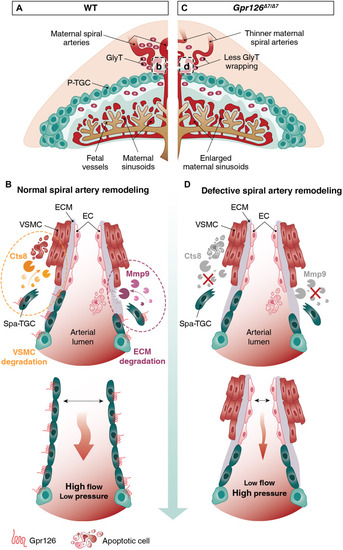Fig. 7.
- ID
- ZDB-FIG-220304-16
- Publication
- Torregrosa-Carrión et al., 2021 - Adhesion G protein-coupled receptor Gpr126/Adgrg6 is essential for placental development
- Other Figures
- All Figure Page
- Back to All Figure Page
|
Model of Gpr126 function in the remodeling of the maternal vasculature of the mouse placenta.
(A to D) Illustrations of an E12.5 WT (A) and a Gpr126?7/?7 (C) placenta. In a WT placenta (A and B), Gpr126 endows TGCs with invasive behavior by regulating the production of Mmp9, together with the capacity to degrade vascular smooth muscle cells through the expression of Cts8. Both activities are required for uterine trophoblast invasion and vascular remodeling during placental development, through which Spa-TGCs replace the maternal endothelial lining and GlyTs congregate around spiral arteries, transforming the maternal spiral arteries from narrow high-resistance, low-flow vessels into dilated vessels, allowing higher blood flow at lower pressure. The Gpr126-null placentas (C and D) fail to express Mmp9 and Cts8, thus impairing trophoblast migration and spiral artery adaptation. Fewer GlyTs wrapped around the unremodeled maternal spiral arteries. As a result of the altered uteroplacental hemodynamics, increased blood pressure triggers an enlargement of the maternal sinusoids. EC, endothelial cell; ECM, extracellular matrix; GlyT, glycogen trophoblasts; VSMC, vascular smooth muscle cell. |

